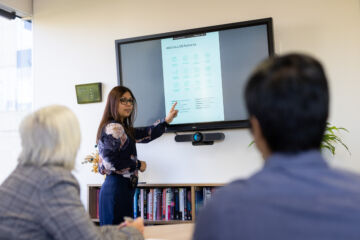This is part 1 of our 2-part series on the power of adaptive learning and personalisation. You can continue reading part 2 at the end of this article.
We know there is no one-size-fits-all approach to education. We simply don’t all learn the same way. When we want to ensure we are deepening engagement and retention of eLearning content, we need to look at how we offer that learning.
That’s where adaptive learning and personalised learning have become increasingly relevant in modern eLearning. As technology in the eLearning space becomes increasingly sophisticated through advancements in AI, tailored learning approaches are becoming increasingly critical to the success of any eLearning course. Rapid improvements to technology are helping to shape personalised learning experiences, leading to transformative eLearning experiences.
Although adaptive learning and personalisation learning are similar, there are some key differences. Let’s start with adaptive learning.
Why adaptive learning works
Adaptive learning harnesses data and analytics to intelligently adjust the learning experience based on the learner experience. eLearning technology can analyse an individual learner’s progress and performance through online training and tailor the content and pace of learning to optimise their learning retention.
In the adaptive learning Australia context, data is harnessed to deliver content that is best suited to each individual learner. There are many benefits to adaptive learning. By its very nature, adaptive learning is more interactive and more engaging than traditional classroom or face-to-face learning.
Adaptive learning is also more efficient by delivering targeted content that focuses on a learner’s biggest areas of need. This tailored approach makes the learning experience that much more personal and therefore meaningful. An adaptive learning process is inherently more inclusive as it can automatically adjust the speed of the learning or provide further learning for students who require more time to grasp the learning outcomes.
The learning is also more accommodating of learner’s schedules, being delivered and accessible flexibly, which contributes to enhanced retention, better engagement, and ultimately higher success rates.
How personalisation enhances learning
Not to be confused with adaptive learning, personalised learning is exactly like it sounds—it focuses on the individual needs of students, giving them the autonomy to tailor their learning experiences to reach their individual goals.
This personalisation can be achieved through modern Learning Management System (LMS) platforms like Moodle. At eWorks our LMS solutions offer customisable learning paths, as well as individual progress tracking for the learner. In fact, with more than 100,000 learners we pride ourselves on being one of the best Learning Management System vendors in Australia. We work closely with our clients to offer a complete one-stop solution, whether you want a completely personalised learning solution from scratch, or you simply want to migrate your existing tools.
Where adaptive learning and personalisation meet
Personalised learning takes a learner-centric approach that allows the learner to take an active role in choosing their learning. This approach goes beyond custom learning by actually adapting to the learner’s own learning process.
A personalised learning journey is also a continuous learning journey. Through adaptive learning technology, such as data analytics, the learner’s journey can be continuously tweaked and updated. This goes even further with personalised learning, which keeps learners engaged for longer as it allows them to stay motivated in the pursuit of the learning that they specifically require.
Taking a holistic approach
Adaptive learning theory relies heavily on data and analytics to objectively track the learner's journey. It is this same data that is crucial to provide tailored, individual learning content and recommendations. It’s hugely helpful, but it requires a large amount of data to be so. Personalisation can use this adaptive learning theory, but it really hinges on learner feedback and taking an active role in their learning.
Personalisation puts the learner in control of their own learning outcomes. You only need to look at the success of language learning apps like Babble or Duolingo to see how successful a holistic approach that incorporates adaptive learning and personalisation can bring huge benefits to any learner and in turn the learner’s organisation or trainer.
Continue reading part two of our two-part series here.
Looking to partner with the LMS and eLearning experts? Our dedicated eWorks team are here to help. Get in touch today at: sales@eworks.edu.au



